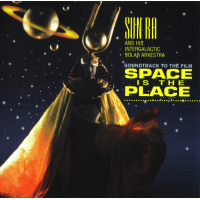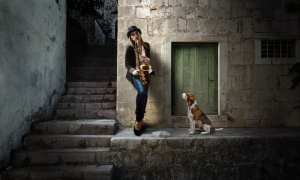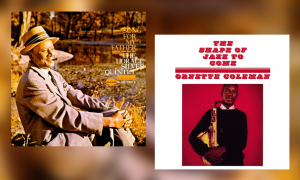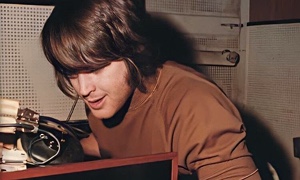Home » Jazz Articles » Building a Jazz Library » Jazz & Film: An Alternative Top 20 Soundtrack Albums
Jazz & Film: An Alternative Top 20 Soundtrack Albums

Jean-Luc Godard had no ideas about the music, so I was completely free. He did once say, 'Why don't you write it for one banjo player?' I thought he was being funny, but you couldn't be sure with him. Anyway, I brought a big band and thirty violins. I never found out if he liked it, but it seems to have worked.
—Martial Solal on his soundtrack for Godard’s A Bout De Souffle
As the 1950s wore on, television joined the party. On big and small screens, jazz became the go-to genre for projects dealing with crime, sex and drugs—bop and hard bop had become perceived by conservative society as synonymous with irresponsible demi-monde pleasure seeking, at best, and outright moral depravity, at worst. The double whammy of white racism and a cultural establishment still in thrall to European notions of art played a significant role here.
Only when rock 'n' roll gave way to rock in the mid 1960s did film makers stop regarding jazz as the touchstone of progressive culture. Great movies and great television using jazz soundtracks continued to be made, but rock now carried the swing.
Jazz soundtracks need to be approached differently than regular jazz albums. Jazz for film tends, in general, to be light on extended improvisation. But it is strong on atmosphere, good tunes and rhythm. Most soundtracks include tracks lasting less than a minute and few last much longer than five minutes. But the combination only sounds bitty if you are unprepared for it. (Additionally, some soundtracks suffer when divorced from the visuals, though this is not true of any of the albums listed below). If you accept all this, and are tolerant of instances of orchestral sweetening and heightened atmospherics sometimes verging on melodrama, then you will have an aural ball.
This alternative top twenty excludes biopic soundtracks, such as the one for Clint Eastwood's Bird (CBS, 1988), and reportage, such as Aram Avakian and Bert Stern's 1958 Newport Jazz Festival documentary, Jazz On A Summer's Day (Charly, 1998). The many wonderful "soundies" produced by the RCM Corporation in the 1940s, which were played on a small screen mounted on top of a coin-operated unit like a jukebox, merit an article to themselves.
The list also excludes such widely celebrated albums as Miles Davis' Ascenseur Pour L'échafaud (Fontana, 1958), Duke Ellington's Anatomy Of A Murder (Columbia, 1959), Herbie Hancock's Blow-Up (MGM, 1966) and Branford Marsalis Music From Mo' Better Blues (Columbia, 1990).
The albums are listed chronologically by year of recording rather than by release date (some mid-twentieth century soundtracks were not released as albums until the 2000s and 2010s). Most of the soundtracks themselves were written for movies, and in one case a TV series, released between 1955 and 1965. There are examples from the US, Britain, Italy, France and Poland.
Hopefully you will find some great music that has so far escaped your attention.
JAZZ & FILM: 20 TREASURES FROM THE CUTTING ROOM FLOOR
 Dizzy Reece Quartet Featuring Tubby Hayes
Dizzy Reece Quartet Featuring Tubby HayesOriginal Jazz Themes From Nowhere To Go
Tempo, 1958 (EP)
British trumpeter Dizzy Reece's pianoless quartet includes two other luminaries of the 1950s London jazz scene, tenor saxophonist Tubby Hayes and drummer Phil Seaman. The film, directed by Seth Holt and Basil Dearden, is a noir thriller in the American tradition and the score is rooted in gritty East Coast hard bop. But both have flashes of local character. There are four tracks, each written by Reece: a moody, minor-keyed "Main Theme," followed by three variations, "The Escape And The Chase," "The Search" and "The Sunset." Reece and Hayes both turn in brief but beautiful solos. "The Escape And The Chase" includes an African-flavoured toms and cowbell solo from Seaman. (The young Ginger Baker first heard African drumming on record at Seaman's flat round about this time). As rare as they get in its original vinyl format, Nowhere To Go was reissued digitally on Trunk Records in 2010.
 Count Basie / Benny Carter
Count Basie / Benny Carter The Music From M Squad
RCA Victor, 1959
A compilation of tracks from the late 1950s NBC TV series in which Lee Marvin starred as a detective in a special unit of the Chicago police. The M stood for Murder but it could equally well have been Macho. Hugely evocative of its era—right down to series sponsor Pall Mall cigarettes—the series' soundtracks are a feast of highly charged atmospherics. Count Basie wrote the theme tune and multi-instrumentalist Benny Carter wrote four of the other tracks selected for this album. Other musicians include trumpeter Pete Candoli, trombonist Frank Rosolino, bassists Joe Mondragon and Red Mitchell and drummers Alvin Stoller and Larry Bunker. M Squad is said to have been the inspiration of the spoof series Police Squad! in the 1980s. Any resemblance between the police force portrayed in M Squad and the Chicago police of 2020 is entirely coincidental.
 Charles Mingus
Charles Mingus Shadows
Doxy, 2015
John Cassavetes' 1959 film Shadows is a study of racial attitudes in bohemian New York City. It was highly regarded by cinéastes when released, but aspects of it are uncomfortably anachronistic in 2020—two of the leading actors are white but used make-up and sun-lamps in order to be portrayed as black. No such caveats surround the music, which was written by bassist Charles Mingus and reeds player Shafi Hadi and was finally released in a limited vinyl edition in 2015. The four tracks are high-grade Mingus of the period. Along with Mingus and Hadi themselves, the band includes pianists Horace Parlan and Richard Wyands, saxophonists John Handy and Booker Ervin, trombonist Willie Dennis and drummer Dannie Richmond.
 Barney Wilen
Barney WilenUn Témoin Dans La Ville
Fontana, 1959
In the 1950s, French cinema made good use of expatriate or visiting American jazz stars. In Britain, meanwhile, the isolationist Musicians Union imposed a near blockade on them. (This is one reason why contemporary British jazz soundtracks were composed and recorded almost exclusively by British musicians). In 1958, Paris-based tenor saxophonist Barney Wilen was the second horn player on Miles Davis' aforementioned Ascenseur Pour L'échafaud. The drummer in the Davis band was Kenny Clarke, who returns for the Wilen-composed soundtrack for Édouard Molinaro's Un Témoin Dans La Ville (A Witness In The City), a revenge thriller based on the murder of a beautiful (quelle surprise) woman. Kenny Dorham is on trumpet, Duke Jordan on piano and Paul Rovère on bass. Wilen was a fine composer and the themes, a mixture of burners, ballads and blues, are as classy as the performances.
 Alain Goraguer
Alain Goraguer J'irai Cracher Sur Vos Tombes
Philips, 1959 (EP)
Pianist Alain Goraguer's score for Michel Gast's J'irai Cracher Sur Vos Tombes (I Spit On Your Graves) was made with an all French band, which acquits itself marvellously. The core lineup is trumpeter Roger Guerin, flautist Raymond Cuiot, vibraphonist Michel Hausser, bassist Pierre Michelot and drummer Christian Garros. Goraguer's arrangements are unabashedly derivative, pastiches of those by John Lewis for the Modern Jazz Quartet. But they are so well crafted that it really does not matter. Sadly, the EP has a playing time of only just over ten minutes. Based on a novel by jazz fanatic Boris Vian, the film treatment was by all accounts a dog. So enraged was Vian by it that he suffered a fatal heart attack after viewing the final cut.
 Modern Jazz Quartet
Modern Jazz QuartetOdds Against Tomorrow
United Artist, 1959
And here we have the actual Modern Jazz Quartet, augmented by a 22-piece orchestra. John Lewis' forays off the jazz bandstand, particularly with Third Stream music, could be brittle, self-conscious affairs. But his score for Robert Wise's Odds Against Tomorrow is a winner, largely because it is realised in an audio-album framework. The tracks include the first recording of "Skating In Central Park," since covered by many jazz musicians (perhaps most sublimely by pianist Bill Evans on Undercurrent, his 1962 United Artists album with guitarist Jim Hall). Unlike most of the albums in this Top 20, there are no cutting-room floor snippets included here, just six full-length tracks, most lasting between five and seven minutes.
 Martial Solal
Martial Solal A Bout De Souffle
The Soundtrack Factory, 2017
The most celebrated of the three French films cited here, Jean-Luc Godard's 1960 masterpiece A Bout De Souffle (aka Breathless) has an outstanding soundtrack written by Algiers-born pianist Martial Solal. Sporadically available since the film's release, sometimes on much condensed EP versions, this reissue is the most complete edition to date. "Godard had no ideas about the music, so fortunately I was completely free," Solal said in 2010. "He did once say, 'Why don't you just write it for one banjo player?' I thought he was being funny, but you couldn't be sure with him. Anyway, I brought a big band and 30 violins. I never found out if he liked it, even now, but it seems to have worked." Trumpeter Roger Guerin and vibraphonist Michel Hausser, from Alain Goraguer's J'irai Cracher Sur Vos Tombes (above), return with distinction.
 Andre Previn / Gerry Mulligan / Carmen McRae
Andre Previn / Gerry Mulligan / Carmen McRaeThe Subterraneans
MGM, 1960
Jack Kerouac's jazz and drug-soaked 1958 novel was given a cliché-rich Hollywood treatment by Ranald MacDougall which was much derided at the time by Allen Ginsberg and other prominent beats. It contains, however, a fine score composed and arranged by André Previn, which possesses an authenticity undiminished by the occasional presence of a string section. The core band is a roll call of contemporary California-based jazz luminaries, including baritone saxophonist Gerry Mulligan, trumpeters Art Farmer and Jack Sheldon, alto saxophonist Art Pepper, tenor saxophonist Bill Perkins and drummer Shelly Manne. Singer Carmen McRae is added on one track.
 Mundell Lowe
Mundell LoweSatan In High Heels
Charlie Parker Records, 1962
A salacious sexploitation movie, Jerald Intrator's Satan In High Heels tells the story of a tent-show stripper and her heroin-addicted husband, thus ticking the three biggest boxes (sex, drugs, crime) for a contemporary movie using a jazz soundtrack. But what a soundtrack. Guitarist and composer Mundell Lowe moves between bop, hard bop and big band over ten mostly steamy tracks, ringing the changes with the occasional foray into cool. He is accompanied by a lineup which includes trumpeters Ernie Royal and Clark Terry, trombonists Urbie Green and Jimmy Cleveland and saxophonists Phil Woods, Oliver Nelson and Al Cohn. The British release was given the title Blues For A Stripper (Egmont, 1962).
 Tubby Hayes
Tubby HayesAll Night Long
Harkit, 2004
A slice of British noir released in 1962, Basil Dearden's All Night Long is based (very loosely) on Shakespeare's Othello. It is set in the contemporary London jazz world and filmed in moody black and white. The music includes some of the most prominent British players of the time including Tubby Hayes on tenor saxophone and vibraphone, Kenny Wheeler and Bert Courtley on trumpet, Keith Christie on trombone, Colin Purbrook on piano and Allan Ganley on drums. Dave Brubeck wrote and played on two tracks, "Blue Shadows In The Street" and a remake of "It's A Raggy Waltz." Charles Mingus plays on Phillip Greenlief's "Noodlin.'" The sixteen tracks are variously credited to the Tubby Hayes Trio, Quartet, Octet and Orchestra.
 Piero Umiliani
Piero UmilianiSmog
RCA Victor, 1962
Considering how many stylish and inventive movies were made in Italy in the 1950s and 1960s, surprisingly few have jazz or jazz-based soundtracks of note. Cinematically inclined composers such as Nino Rota and Ennio Morricone included jazz in their palettes but those palettes were multi-hued. Piero Umiliani's score for Franco Rossi's Smog, a dark drama set in Los Angeles, stands out. Recorded in Rome by a mostly Italian lineup, two tracks feature singer Helen Merrill and five others feature trumpeter Chet Baker, then resident in Italy. Smog was the second Umiliani-scored movie featuring Baker on the soundtrack, following Mario Monicelli's I Soliti Ignoti (retitled Big Deal On Madonna Street on international release).
 Dizzy Gillespie
Dizzy GillespieThe Cool World
Philips, 1964
Independent film maker Shirley Clarke's docudrama The Cool World examines the day-to-day lives of the members of a street gang in Harlem. Actual gang members were part of the cast. Despite a sensationalist advertising campaign—"Hooker! Fuzz! Junk! Rumble!" screamed the posters—the film was praised by movie critics as succeeding both as social realism and as a work of imaginative art. Mal Waldron's soundtrack does it proud. Dizzy Gillespie leads a quintet including James Moody on saxophones and flute and Kenny Barron on piano. George Kanzler's 2009 review in All About Jazz nails it: "alternately dark and moody and exhilaratingly brisk.... one of the great jazz film scores."
 Neil Hefti
Neil HeftiSynanon
Liberty, 1965
Art Pepper and Joe Pass were among several dozen jazz musicians who in the late 1950s and 1960s attempted to cure their heroin habits at the pioneering facility Synanon House in California. Sometimes the program worked, too. As movie posters go, however, the visual montage used for Richard Quine's Synanon was about as clichéd and sensationalist as they got in the mid 1960s. "Everyone is talking about Synanon House...where dope fiends fight their way back!" ran the pull quote. One might expect a similarly melodramatic score from Neal Hefti, but most of the time his "orchestra" is a quintet, judiciously augmented by horns and a string section. There is some real corn to be heard, but the best tracks are a cross between chilled soul-jazz and so-called West Coast cool featuring Plas Johnson on tenor saxophone, Jimmy Rowles on organ, Howard Roberts on guitar, Red Mitchell on bass and Earl Palmer on drums.
 Stan Getz
Stan GetzMickey One
MGM, 1965
Five years after Stan Getz and arranger Eddie Sauter recorded the historic Focus (Verve, recorded 1959, released 1964), the partnership resumed along similar lines for the soundtrack of Arthur Penn's dissection of urban paranoia, Mickey One. Getz had made a suicide attempt a few weeks before the recording sessions and it may be that his tormented frame of mind contributed to the intensity of his performance. "What is the sound of terror? The sound of loneliness, fear in the city?" said Penn in an interview coinciding with the film's release. "For me it would be the sound created by Stan Getz." Getz was often a passionate player but he rarely played with such ferocity as here. Sauter's jazz-based score also includes Polish polkas and 1950s-style rock 'n' roll.
 Albert Ayler
Albert AylerNew York Eye And Ear Control
ESP, 1965
If you want ferocity of a more abstract nature, this album has your name on it. New York Eye And Ear Control is near-forgotten experimentalist movie shot in New York City in 1964 by the Canadian painter and sculptor Michael Snow. But the soundtrack has staying power. It stands alongside John Coltrane's Ascension (Impulse!, 1966) and Ornette Coleman's Free Jazz (Atlantic, 1961) as a landmark in free-jazz of the era. Tenor saxophonist Albert Ayler's honks and screams are complemented by trombonist Roswell Rodd's gutbucket wails and trumpeter Don Cherry's fractured melodicism.
 Mal Waldron
Mal WaldronSweet Love, Bitter
Impulse!, 1967
Herbert Danska's Sweet Love, Bitter opens with jazz musician Richie "Eagle" Stokes (the ornithological reference is intended) lying dead in bed, washed up and alone. The film then follows the drugs, alcohol and sex fuelled life-style that led him there. Dick Gregory was said to be convincing in the lead role but the film was regarded as pretty trashy. Mal Waldron's tough, dark hard-bop score, however, is the business. He is accompanied by Dave Burns on trumpet, George Coleman on tenor and alto saxophones, Charles Davis on baritone saxophone, Richard Davis and George Duvivier alternating on bass, and Al Dreares on drums.
 Quincy Jones
Quincy JonesThe Deadly Affair
Verve, 1967
Sidney Lumet's The Deadly Affair is a spy thriller based on Call For The Dead, the debut novel by Britain's master of that genre, John le Carré. Quincy Jones' soundtrack is in key respects a close relation of Miles Davis' Teo Macero-produced album Quiet Nights (Columbia, 1963). Both have bossa nossa vibes and both are dangerously, or deliciously, take your pick, close to easy listening. Davis was so disgusted with his album that he shut Macero out of his life for years afterwards. Jones had no such problem. The soundtrack was produced by Creed Taylor and as head honcho at Verve he could do what he liked (providing he shifted the units). Astrud Gilberto does her sultry, sophisticated thing on opening track "Who Needs Forever" and the mood is sustained throughout. Hank Jones is the pianist in an otherwise uncredited lineup.
 Krzysztof Komeda
Krzysztof KomedaCul-De-Sac / Knife In The Water
Harkit, 2005
Roman Polanski's noir masterpieces Knife In The Water (1962) and Cul-De-Sac (1966) had soundtracks written by Polish jazz icon (for once the word is justified) Krzysztof Komeda. Between times Komeda had recorded his chef d'oeuvre, Astigmatic (Muza, 1967), with a quintet which featured the then unknown trumpeter Tomasz Stańko. Whatever one might think of Polanski following later allegations of paedophilia, these are both monumentally great movies. No moral qualms spoil the enjoyment of Komeda's singular, nuanced soundtracks. After doing so much to lay the foundations of a distinctive Polish jazz sound, Komeda died in 1969 following an accident in Los Angeles, where he had been writing the score for Polanski's Rosemary's Baby.
 Art Ensemble Of Chicago
Art Ensemble Of ChicagoLes Stances A Sophie
Nessa, 1970
In July 1970, the Art Ensemble Of Chicago had just fourteen days left on their French visas when director Moshé Mizrahi asked them to provide the soundtrack for his feminist-inspired Les Stances A Sophie . No problem. The AEC turned in a high-grade recording which some rather breathless critics have labelled its finest album. Trumpeter Lester Bowie's wife, the singer Fontella Bass, plays piano and turns in a soulful tour de force on "Theme De Yoyo." Also present are Malachi Favors on bass, Joseph Jarman and Roscoe Mitchell on reeds, and Don Moye on drums. The music covers pretty much the full spectrum of the AEC palette, from R&B to bop to free improv to New Orleans jazz.
 Sun Ra & His Intergalactic Solar Arkestra
Sun Ra & His Intergalactic Solar Arkestra Soundtrack To The Film Space Is The Place
Evidence, 1993
Nothing pertaining to Sun Ra is entirely straightforward. Released in 1993, Soundtrack To The Film Space Is The Place was recorded in San Francisco in 1972, the same year that Jim Newman's film Space Is The Place began shooting and the Blue Thumb album Space Is The Place (1973) was recorded in Chicago. To add to the confusion, some of the track titles (but not the content) is duplicated across the two albums. Newman's movie was originally planned as a biopic (and as such would not qualify for inclusion here), but, guess what, things did not go to plan. Rather surprisingly, Newman said later that Ra took directions well, but, less surprisingly, that he kept going off the script or ignoring it. The movie that was finally completed was part science fiction, part blaxploitation and part revisionist version of the Bible. It is weird. But whether a biopic would have been any less weird is a moot point. The music is weird too, wonderfully weird.
Photo: Charles Mingus.
Tags
Building a Jazz Library
Chris May
Miles Davis
duke ellington
Herbie Hancock
Branford Marsalis
Frank Waxman
Elmer Bernstein
Pete Candoli
Jack Dumont
Charles Gentry
Joe Mondragon
Bernard Herrmann
Dizzy Reece
Tubby Hayes
Phil Seaman
Ginger Baker
Count Basie
Benny Carter
Frank Rosolino
Red Mitchell
Alvin Stoller
Larry Bunker
Charles Mingus
Shafi Hadi
Horace Parlan
Richard Wyands
John Handy
Booker Ervin
Willie Dennis
Dannie Richmond
Barney Wilen
Kenny Clarke
Kenny Dorham
Duke Jordan
Paul Rovère
Alain Goraguer
Roger Guérin
Raymond Cuiot
Michel Hausser
Pierre Michelot
Christian Garros
John Lewis
Modern Jazz Quartet
Bill Evans
Jim Hall
Martial Solal
Gerry Mulligan
Art Farmer
Jack Sheldon
Art Pepper
Bill Perkins
Shelly Manne
Carmen McRae
Mundell Lowe
Ernie Royal
Clark Terry
Urbie Green
Jimmy Cleveland
Phil Woods
Oliver Nelson
Al Cohn
Kenny Wheeler
Bert Courtley
Keith Christie
Colin Purbrook
Allan Ganley
Dave Brubeck
Phillip Green
Nino Rota
Ennio Morricone
Helen Merrill
Chet Baker
Mal Waldron
Dizzy Gillespie
James Moody
Kenny Barron
Joe Pass
Neal Hefti
Plas Johnson
Jimmy Rowles
Howard Roberts
Earl Palmer
Stan Getz
Eddie Sauter
John Coltrane
Ornette Coleman
Albert Ayler
Roswell Rodd
Don Cherry
Quincy Jones
Teo Macero
Creed Taylor
Astrud Gilberto
Hank Jones
Krzysztof Komeda
tomasz stanko
Lester Bowie
Fontella Bass
Malachi Favors
Joseph Jarman
Roscoe Mitchell
Don Moye
Sun Ra
PREVIOUS / NEXT
Support All About Jazz
 All About Jazz has been a pillar of jazz since 1995, championing it as an art form and, more importantly, supporting the musicians who make it. Our enduring commitment has made "AAJ" one of the most culturally important websites of its kind, read by hundreds of thousands of fans, musicians and industry figures every month.
All About Jazz has been a pillar of jazz since 1995, championing it as an art form and, more importantly, supporting the musicians who make it. Our enduring commitment has made "AAJ" one of the most culturally important websites of its kind, read by hundreds of thousands of fans, musicians and industry figures every month.




















